

HEALTHY LIVING | HEALTHY PLANET FREE Homemade Pet Remedies FOOD & NUTRITION Optimal Sleep for Kids Plant-Based Eating for the Win METRO PHOENIX & NORTHERN ARIZONA EDITION MARCH 2023


ENGAGE
Check out and post “What’s New”. Be Inspired, find opportunities, upcoming events & more
& join 200+ RWH Topic Communities. Power Search centralized local & global knowledge & resources



LEARN
Your way from thought leaders and experts (curated articles, online webcasts, courses, live events
CONNECT
With your best matched, screened providers and organizations, plus like-minded members
HEAL
With top doctors & experts in live video Q&A. Plus get members-only discounts on their programs
SHOP
Access to a vast growing catalog of courses. Plus, curate your own library to track your progress
DISCOUNTS
On top provider and expert services, healing programs, training, courses & products
Top In-Hub thought leaders and missionaligned partner communities with exclusive benefits
Invited!
the only all-in-one trusted online Whole Health Hub (an ecosystem of communities) with the Exclusive Experience
health and well-being journey easier.
WHOLE HEALTH
Together We Inspire and Empower WELLthier Living – Happy. Healthy. People. Planet. Purpose. Priceless lifetime, life-changing whole health benefits for less than the cost of a smoothie a week! Scan Here for Your Exclusive, Limited-Time Only LIFETIME MEMBERSHIP Your WHOLE HEALTH experience
You’re
Join
that will make your
REGENERATIVE
HUB
FREE
EXPLORE
++ + + + + + +
VIP
ATTEND
FILMS & EVENTS ACCESS ORGANIC FOODS















ONLINE EXCLUSIVES NaturalAZ.com VISIT US ONLINE @ Find additional articles online at NaturalAZ.com. Go to the homepage and explore local businesses and articles exclusively from Natural Awakenings. SHARE YOUR COMMENTS JOIN US ON: COMMUNITY SPONSORS MyNaturalDentist.com Natural Dental Partners SWIHA.edu HEALTHY LIVING | HEALTHY PLANET FREE Homemade Pet Remedies FOOD & NUTRITION Optimal Sleep for Kids Plant-Based Eating for the Win METRO PHOENIX & NORTHERN ARIZONA EDITION MARCH 2023 CALENDAR Check out the latest events at naturalaz.com/calendar NatPainTreat.com wise words TERRY WAHLS on Managing Autoimmune Disease With Lifestyle Interventions global briefs Crackdown on Musical Bows Made from Rare Wood Nations Agree to Protect Biodiversity
ADVERTISING
HOW TO ADVERTISE
To advertise with Natural Awakenings or request a media kit, please email PhoenixAds@NaturalAZ.com

Deadline for ads: the 10th of the month.
EDITORIAL SUBMISSIONS
Go to NaturalAZ.com/pages/contact to inquire about editorial opportunities. Deadline for editorial: the 10th of the month.
CALENDAR SUBMISSIONS
Calendar events are online only, and can be submitted at NaturalAZ.com/calendar
NATIONAL MARKETS
Advertise your products or services in multiple markets!
Natural Awakenings Publishing Corp. is a growing franchised family of locally owned magazines serving communities since 1994. To place your ad in other markets call 239-206-2000. For franchising opportunities call 239-206-2000 or email NaturalAwakenings@KnoWEwell.com.
14 VEGGIES FOR THE WIN
Five Reasons to Choose a Plant-Based Lifestyle

17 WHOLESOME FOOD EQUALS A HEALTHY BODY AND MIND
19 THE CELLULAR MAGIC OF COMPASSION
20 LOVING OUR KIDNEYS
Edible Allies, Integrative Treatments and Lifestyle Tips
23 INTRAVENOUS NUTRITIONAL THERAPY
24 FINDING HOPE IN ACTION
Saving Earth and Water With Small Steps

26 WORK HARDER AND SMARTER
Benefits of High-Intensity Interval Training
28 THRIVING WITH MULTIPLE SCLEROSIS
How to Reduce Inflammation and Promote Neuroregeneration
30 SWEET LULLABY Better Sleep for Children
32 GIVE YOUR CHILD A LIFETIME OF HEALTH

7 March 2023
is a network of
empowering
with
Contents DEPARTMENTS 6 visit us online 10 health briefs 12 global briefs 13 eco tip 19 inspiration 20 conscious eating 24 green living 26 fit body 28 healing ways 30 healthy kids 34 natural pet 36 business directory 38 farmers markets
Natural Awakenings
natural lifestyle magazine publishers
local communities
knowledge, resources and connections to lead healthier lives on a healthy planet.
14
& SUBMISSIONS 24 30
34 NATURAL REMEDIES FOR PETS Seven Non-Toxic Treatments for Common Ailments 34
PHOENIX & NORTHERN ARIZONA EDITION
PUBLISHER
Tracy Patterson, BSc, MES DESIGN & PRODUCTION
Vegetorium, LLC

COPY EDITOR
Sara Gurgen
DIGITAL PLATFORMS
Hass Solutions Locable
CONTACT US
Natural Awakenings – Phoenix 17470 N Pacesetter Way Scottsdale, AZ 85255
Tracy@NaturalAZ.com NaturalAZ.com

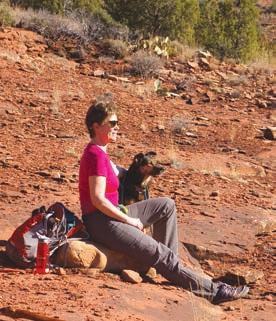
NATIONAL TEAM
CEO Kimberly B. Whittle
COO/Franchise Sales

Joe Dunne
National Editor Sandra Yeyati
Editor Brooke Goode
Copy Editor/Proofreader Melanie Rankin
Design & Production Gabrielle W-Perillo
National Advertising Lisa Doyle-Mitchell
Plant-Based Lifestyle
This month’s feature article, on page 14, got me thinking about the plant-based lifestyle. To me, “plant-based” means just that, based on plants, but it can also include some meat, although in lesser quantities and specific kinds, such as fish or white-meat poultry. The problem with replacing animal proteins entirely is that I do not do well on beans, and find some of the faux meats unpalatable (and they, along with tofu, are processed!).
One of the things I keep in mind is that not all vegetables and fruit are created equal. It never occurred to me back in the day when we used to rid our broccoli and cauliflower of worms by soaking them in saltwater, that a time would come when I would actually wish for this problem. I don’t think there’s ever any fear of a worm within a mile of cruciferous vegetables these days, thanks to the multitude of pesticides that are liberally applied. Same goes for black spots on tomatoes and peppers—they may look beautiful nowadays minus the blemishes, but their taste leaves much to be desired!
My husband and I usually eat organic now, but often the produce comes from commercial greenhouses (so still no worms!). Greenhouse organics may have the health benefit of no pesticides, but aren’t often teeming with flavor and may be low in nutritional value, especially if they aren’t grown in soil—where the vitamins and minerals we get from vegetables and fruit actually come from. And when grown outdoors, large commercial producers often practice monoculture farming, which depletes the soils of nutrients, leaving the produce sadly lacking.
The good news is that there are still local organic farmers who plant crops in the great outdoors and practice soil conservation. Not only are we supporting their efforts when we buy from them, but we can find an array of tasty and nutritious veggies and fruits that go a long way to keeping us in the plant-based lifestyle that many of us are striving for.
© 2023 by Natural Awakenings. All rights reserved. Although some parts of this publication may be reproduced and reprinted, we require that prior permission be obtained in writing.

Natural Awakenings is a free publication distributed locally and is supported by our advertisers. Please contact us to find a location near you.
We do not necessarily endorse the views expressed in the articles and advertisements, nor are we responsible for the products and services advertised. Check with a healthcare professional regarding the appropriate use of any treatment.
DEADLINE REMINDER!
Please note that all deadlines (advertising and editorial) are the 10th of the month prior to the edition being published. For example, March 10 is the deadline for all April edition submissions.

8 Metro Phoenix & Northern Arizona Edition NaturalAZ.com
Natural Awakenings Magazine is ranked 5th Nationally in CISION’S 2016 Top 10 Health & Fitness Magazines letter from publisher
HEALTHY LIVING HEALTHY PLANET

Gut Microbiome May Influence Obesity

Walnuts to Relieve Exam Stress
Stressed college students might benefit by adding walnuts to their diet before their next exam. A randomized clinical trial published in the journal Nutrients sought to investigate the effects of academic stress and daily walnut consumption on mental health, general well-being and gut microbiota in a group of 80 college students. Walnuts are full of nutrients that support brain and gut health, including omega-3 fatty acids, antioxidants, melatonin (sleep-inducing hormone), polyphenols, folate and vitamin E.
A new study may shed light on why some people gain more weight than others regardless of diet and activity levels. Led by researchers at the University of Copenhagen and published in the journal Microbiome, the study found that being overweight may also be related to the makeup of a person’s gut microbiome. The researchers studied 85 overweight adults and found that 40 percent of the participants had more Bacteroides in their gut microbiome, which are more effective at extracting nutrients from food, possibly causing leftover food to be stored as fat. Before they began their study, the researchers had hypothesized that a long digestive travel time would allow people to extract more energy from their food, but they found instead that people with shorter digestive travel times were actually the ones that extracted the most nutrition. Those with Bacteroides had shorter intestinal transit times and higher body weight.
Human-Grade Dog Foods Lead to Less Poop
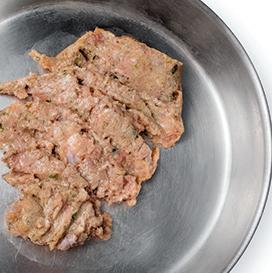
Although human-grade foods for pets are commercially available, little research has been done on their health impacts. A 2021 study published in the Journal of Animal Science compared the fecal output of 12 dogs that ate one of three types of dog food: fresh, human-grade or extruded (kibble). The researchers found that the dogs that were fed fresh and human-grade food excreted about half as much as those that were fed classic, processed dog food. The human-grade foods were also found to be extremely digestible, and the dogs that ate them had to eat less food to maintain the same weight. There were many differences in fecal microbiota among the three diets, and the scientists stated that this was likely because of differences in ingredient source, nutrient concentrations and processing methods.
The University of South Australia researchers concluded that daily consumption of one half cup of walnuts improved self-reported mood and mental health status, metabolic biomarkers and sleep quality. The data also suggested that walnuts might counteract the negative effects of academic stress on the gut microbiota in women. The scientists noted that more research was needed with respect to males, as far fewer men participated in this study. They also cautioned that the placebo effect could have influenced results, as this was not a blind study.

Supplements That Help the Heart
A new study conducted by researchers at Brown University has identified certain supplements that may be beneficial for heart health. The meta-analysis published in the Journal of the American College of Cardiology reviewed more than 884 studies on 27 types of micronutrient supplements among 883,627 participants and found strong evidence that omega-3 fatty acid, folic acid and coenzyme Q10 (CoQ10) are micronutrients that reduce cardiovascular risk. Omega-3 fatty acid was found to decrease mortality from cardiovascular disease; folic acid lowered stroke risk; and CoQ10 decreased all-cause mortality. Omega-6 fatty acid, L-arginine, L-citrulline, melatonin, magnesium, vitamin D, zinc, alpha-lipoic acid, catechin, flavanol, curcumin, genistein and quercetin also showed evidence of reducing cardiovascular risk.

10 Metro Phoenix & Northern Arizona Edition NaturalAZ.com health briefs
KucherAV/ShutterStock.com
Ssdecoret/ShutterStock.com
sophiecatShutterStock.com DionisveraAdobeStock.com






VISIT OUR ONLINE STORE: www.SWHerb.com/shop • Advanced Formulation weekend April 29 & 30, learn how to mix all those herbs into powerful medicine. Explore how to conduct an herbal consultation. $299pp (Strong herbal knowledge required) • Summer 2-Weekend Herbal Cert Course, June 3, 4, 10, 11. $100 non-refundable deposit holds your seat. Taking RSVPs, don’t hesitate! SW Herb Shop Upcoming 2023 Classes Unresolved Health Issues? Did you know that … Anxiety / Depression Chronic Fatigue Unexplained Weight Gain High Blood Pressure Loss of Libido Reduced Immune Function Persistent Aches & Pains “ May be related to Sleep Disordered Breathing? and download a FREE copy of my book “A Breath of Health” to learn how we address the ROOT CAUSE of this problem. Dr. Ingo Mahn ABreathofHealth.com 602-922-7852 I - 17 and Carefree Hwy
Wooden Wind Turbines

First Honeybee Vaccine Approved

Wind turbines provide one of the cleanest sources of energy; the power they produce is free, helping us reduce our dependence on fossil fuels. Several European companies are working to improve wind turbines by further reducing their carbon footprint. Stora Enso, one of the largest private forest owners in the world, has partnered with Voodin Blade Technology of Germany to make sustainable wooden, wind turbine blades. They are currently producing 66-foot blades and plan to make 262-foot blades in the
According to the U.S. Department of Agriculture (USDA), more than 100 U.S. crops depend on pollination by honeybees and other insects. Safeguarding commercial honeybee colonies is critical to food production as there has been an alarming population decline in wild species due to habitat loss, pesticide use and the climate crisis.
Recently, the USDA granted a two-year conditional license for a vaccine that protects honeybees from American foulbrood disease (AFB), a widespread, destructive ailment. The non-GMO inoculation will initially be available to commercial beekeepers and can be used in organic agriculture.
Prior to this booster, the only treatment method for AFB required beekeepers to burn the infected hives and equipment. According to vaccine manufacturer Dalan Animal Health, their vaccination is incorporated into the royal jelly, which worker bees feed to the queen. Once ingested, fragments of the treatment are deposited in the queen’s ovaries, providing developing larvae AFB immunity as they hatch.
Injured Whale Makes Long Journey
Each year, humpback whales migrate from the frigid waters near Alaska and western Canada to the warm waters of Mexico and Hawaii to breed and give birth. At the end of 2022, an extraordinary whale named Moon made the 3,100-mile journey from British Columbia to Hawaii with a broken back. The Canadian researchers that have been tracking Moon for the past decade discovered that the entire lower portion of her tail was bent into an unnatural “S” shape, presumably as a result of a boat strike.
Researchers speculate the whale made the arduous journey without the use of her tail, essentially using the breaststroke to make her migration. The journey left Moon emaciated when she reached Hawaii, having used up her fat stores and with no hope of recovery, given the scarce food resources in the tropical waters. Moon’s story serves as a cautionary tale for the devastating effects of ship collisions with whales. Boaters are reminded to treat whale areas like school zones and slow down to keep marine creatures safe.

global briefs
cfhdesign/AdobeStock.com
DasyaDasya/AdobeStock.com
Eco-Friendly Water Heating

annual hot water costs in half. Homes that generate their own power with solar panels may eliminate the annual cost altogether.
Another option is a heat pump water heater that uses 70 percent less energy than standard water heaters and is currently eligible for a $300 federal tax credit. According to Energy Saver, a U.S. Department of Energy consumer resource (Energy.gov), heat pump water heaters use electricity to move heat from one place to another instead of generating heat directly.
After installing a new unit, be sure to recycle the old water heater. Ask the retailer of the new appliance if they participate in a take-back program, or coordinate with the installer to arrange for proper recycling.
When it comes time to replace the water heater, homeowners have an opportunity to save money and significantly lower their carbon footprint by choosing more efficient appliances. In the U.S., most homes are equipped with water heaters that require a large storage tank. The water has to be heated continually, leading to $400 to $600 water heating bills every year.
A tankless model requires less space, lasts longer and costs less to operate. Because it does not hold water, cold water flows into the unit and is heated only when needed. This can

save energy because the unit does not need to heat gallons of water that aren’t being used.
One drawback is that tankless devices may require a gas line and may be a challenge for older homes because of the necessary permits and electrical upgrades. Whether it has a tank or not, choose an Energy Starcertified model, which is deemed to be more efficient and often comes with a rebate or tax credit. Visit EnergyStar.gov for more information.
Some people may opt for a solar water heating system, which can cut
If the water heater doesn’t need replacement yet, consider that for every 10-degree decrease in the temperature setting on a conventional tank there is a corresponding 3 to 5 percent energy savings. Lower temperatures also reduce mineral buildup and corrosion in the tank and pipes.
Keep in mind that the easiest way to lower a household’s water heating is simply to use less hot water. Look for ways to decrease the family’s use of hot water by taking baths or shorter showers, washing laundry with cold water and running the dishwater on the energy-efficient setting.
Check


13 March 2023 eco tip
Web Buttons Inc/AdobeStock.com
Bring this Ad for 10% OFF Off!! Upcoming Events Ancala Village, 11108 N. Frank Lloyd Wright Blvd., Suite #E-16, Scottsdale, AZ 85259 https://DimensionsofHeavenandEarth.com The Magic Awaits at Heaven & Earth DIMENSIONS OF Celebrate the magic of St. Patrick’s Day with crystals, pendulums, soaps, essential oils, herbal teas, meditations, spiritual classes, and more! MAR 7 REIKI LVL II CERTIFICATION MAR 11 MAR 19 MAR 26 INTRODUCTION TO SPIRIT GUIDES FULL MOON CLEANSING MEDITATION INTRODUCTION TO PSYCHIC DEVELOPMENT
CALENDAR
out the latest events at naturalaz.com/calendar
Veggies for the Win
FIVE REASONS TO CHOOSE A PLANT-BASED LIFESTYLE
 by Kiki Powers, MS, CNC
by Kiki Powers, MS, CNC
Many of us have come across the term “plant-based eating”. Perhaps the regimen was recommended to us by a medical or nutritional professional. We may have read about it in a magazine or seen a documentary on the subject. Scientists around the globe have studied this lifestyle choice, and persuasive evidence is mounting that eating a preponderance of foods from plant sources has health merits.
The concept is attributed to T. Colin Campbell, Ph.D., the Jacob Gould Schurman professor emeritus of nutritional biochemistry at Cornell University. Based on his extensive research, he has advocated a low-fat, whole food, plant-based diet since the 1980s, and his commentary appears in Forks Over Knives, an influential 2011 documentary on the subject that is still worth viewing.
Americans love their cheeseburgers and french fries, and breaking a habit that we thoroughly enjoy might be challenging at first. But we need not completely ban such delights from our menu, so long as our plates are brimming with vegetables, fruits, legumes, whole grains, beans, healthy oils, nuts and seeds most of the time. Gradually transitioning to a whole food, plant-based, low-fat diet is the winning formula for positive change and longterm compliance.
Here are five compelling reasons to make this promising dietary shift.
Cost-Effective Disease Prevention
As so many Americans struggle with chronic health issues, including obesity, diabetes and heart disease, physicians are hard-pressed to find the right combination of treatments to help their patients lead healthier lives. At the same time, healthcare costs continue to skyrocket. In 2020, health spending rose to $4.1 trillion, or $12,530 per capita, according to the American Medical Association.
In a 2013 article published in The Permanente Journal, California physicians surveyed leading research and case studies and found that plant-based diets offer patients a low-risk, cost-effective intervention to regulate weight, blood pressure, blood sugar and cholesterol
levels. They also asserted that such eating regimens could reduce the number of medications patients would have to take for chronic disease, and that physicians should recommend such diets to all of their patients, especially those suffering from high blood pressure, diabetes, cardiovascular disease or obesity.
Besides saving money on drugs and medical procedures, a plant-based menu has never been easier or more affordable. According to recent data conducted by the UK nonprofit Veganuary, plant-based meals eaten at home cost 40 percent less than meat- or fish-based meals and take onethird less time to prepare.
“The most powerful tool I discovered while in practice for both preventing and treating chronic diseases such as diabetes, obesity, heart disease, high blood pressure and arthritis was the implementation of a plant-based nutritional plan to a patient’s life,” says Ted Crawford, a board-certified family physician featured in two inspiring documentaries about the life-changing benefits of a plant-based diet: Eating You Alive and PlantWise.
14 Metro Phoenix & Northern Arizona Edition NaturalAZ.com
Alexander Raths/AdobeStock.com
Flavor, Freshness and Flavonoids
The latest food trend is a “burger” made entirely of plants. The race is on to see which one looks and tastes closest to a juicy, all-beef patty. Whether it’s mushrooms posing as “steak” or wheat-based seitan kneaded into “chicken”, recipes catering to carnivores have their audience. For some, these tasty alternatives may offer a path toward becoming a vegetarian or vegan.
Oven-roasted on a sheet pan, splashed with extra virgin olive oil and lemon juice, sprinkled with fresh herbs and spices, served with a creamy dip, slow-cooked in a crockpot, baked into a pie, frothed into a sweet smoothie or freshly pulled from the vine, consider the fact that whole, plant-based foods taste delicious on their own and deserve the spotlight.
They are good and good for us, packed with nutrition while low in fat and calories. The vibrant colors of fruits and vegetables—as varied as the rainbow—are evidence of the many healthful attributes they offer. Ditching animal fats, white flour and sugar in favor of fresh, whole plant foods found at a local farmers market ensures a rich intake of vitamins, minerals, trace elements, phytonutrients, fiber, antioxidants, flavonoids, protein, fiber and more—the building blocks of a robust, disease-fighting body.
Those that believe a plant-based diet is too limiting might be surprised to learn that there is a wealth of meat-free culinary possibilities. Garth Davis, M.D., author of Proteinaholic: How Our Obsession With Meat Is Killing Us and What We Can Do About It, notes, “Just 12 plants and five animals compose about 75 percent of the world’s food, and yet there are approximately 300,000 known edible plant species, only about 150 of which are used commonly around the world.”
There are so many plant-derived flavors and recipes yet to explore. Try a new plant-based recipe weekly. Let the kids select their favorite fruits and veggies to prepare. Enjoy reimagining old favorites like lasagna, enchiladas, chili and tacos. Simply swap out the meat in favor of beans, tofu, tempeh or faux meat products, which have become quite sophisticated in recent years.
PLANT-BASED RESOURCES
Documentary Films championing plant-based diets

n PlantPure Nation
n Forks Over Knives
n Eating You Alive
n What the Health
Websites offering tips, recipes and advice for plant-prominent menus
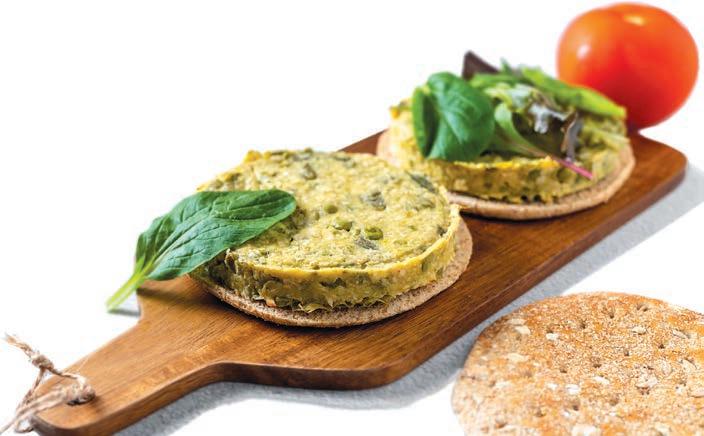
n HappyHerbivore.com
n ForksOverKnives.com
n NoraCooks.com
n CleanFoodDirtyGirl.com
Cookbooks that make whole, plant-based foods shine
n Oh She Glows Every Day, by Angela Lindon
n The Happy Herbivore Cookbook, by Lindsay S. Nixon
n The PlantPure Nation Cookbook, by Kim Campbell
n The China Study Cookbook, by LeAnne Campbell
15 March 2023
Click9/AdobeStock.com
Anti-Inflammatory Benefits
While acute inflammation is a protective bodily response to heal infections and repair tissues, metabolic inflammation—or metaflammation—refers to chronic, systemic inflammation. According to a 2020 study published in The Journal of Allergy and Clinical Immunology, metabolic inflammation is associated with increased risk of Type 2 diabetes, nonalcoholic fatty liver disease and cardiovascular disease.
Numerous studies have explored the inflammatory and anti-inflammatory effects of foods. According to a 2021 article in Harvard Health Publishing, the following foods cause inflammation: refined carbohydrates like white bread; fried foods like french fries; sodas and other sugary drinks; red meat; processed meat, including hot dogs, sausage and cold cuts; and margarine, shortening and lard. Conversely, the best anti-inflammatory foods are tomatoes; olive oil; leafy, green vegetables such as spinach, kale and collards; nuts like almonds, walnuts, pistachios and pecans; and fruit such as apples, strawberries, blueberries, cherries and oranges. Omega-3 fatty acid-rich fish like salmon, mackerel, tuna and sardines are also recommended for their anti-inflammatory properties.
Environmental Sustainability
According to the Food and Agriculture Organization of the United Nations, total greenhouse gas emissions from global livestock represents 14.5 percent of all greenhouse gas emissions worldwide. Cattle raised for both beef and milk are the animal species responsible for
the most emissions, which include methane and represent about 65 percent of the livestock sector’s emissions. Industrially produced meat is also a leading contributor of global deforestation and habitat loss as large swaths of the Amazon and other land masses are cleared for cattle ranching and to produce animal feed.
According to a new model developed by California scientists and published in the journal PLOS Climate, a global phase-out of animal agriculture and a shift to plant-based diets over the next 15 years would have the same effect as a 68 percent reduction of carbon dioxide emissions through the end of 2100, thereby boosting humanity’s chances of avoiding the projected devastation of climate change. Such benefits would result from a decline in the methane and nitrous oxide emissions associated with industrialized meat production, coupled with a recovery of natural ecosystems as fewer forests and land masses are cleared for animal feed production.
Improved Mental and Emotional Health
Sarah Thomsen Ferreira, an integrative registered dietician and manager of clinical nutrition at the Cleveland Clinic Center for Functional Medicine (CCCFM), notes, “Certain foods and nutrients help your brain to make chemicals that can impact your mood, attention and focus, while other foods can zap your energy.” The CCCFM recommends a diet that combines complex carbohydrates with lean proteins and colorful produce. While lean proteins may include white-fleshed fish and white-meat poultry, healthy, plantbased, lean proteins are also found in beans, peas, lentils and tofu. Diet can support emotional well-being and perhaps even help ward off depression and anxiety. A 2017 clinical trial explored how a plant-based diet, daily exercise and mindfulness techniques would affect 500 adult men and women diagnosed with moderate to severe depression and anxiety. After 12 weeks, participants reported improvements in depression and anxiety, according to the study abstract published in the journal Complementary Therapies in Clinical Practice
Eating a plant-based diet makes sense on many levels. Make the switch.
Kiki Powers is a health writer, blogger and national speaker specializing in plant-based nutrition and healthy green living. Learn more at RawKiki.com.

16 Metro Phoenix & Northern Arizona Edition NaturalAZ.com
barbone/shutterstock.com
marilyn
Wholesome Food Equals a Healthy Body and Mind
by Judyth Shamosh, Ph.D.
Using wholesome food promotes good health just as the improper use of food can cause disease. If your diet is inappropriate, medicine is of little use. However, if your diet is wholesome, medicine is of little need and your food becomes your medicine.
Dr. Robert Svoboda, Ayurvedic physician, says, “…the main factor that makes for disease is the indulgence in unwholesome diet.” He adds, “The fundamental cause for all toxins (ama)—the source of disease, is indigestible desire.” Desire can be in the form of unwholesome foods we have been accustomed to eat. These unwholesome foods are those we tend to crave and know are not good for us. In Ayurveda, choosing to eat those foods is called “crimes against wisdom.”
Michael Greger, M.D., in his wellresearched book How Not to Die, provides substantial evidence that a whole food,
plant-based diet is the best way to avoid disease. This includes the sub-clinical disease patterns (undetectable by Western medicine) that damage our ability to accurately perceive and interpret our world and the functioning of our bodies.
This viewpoint is also supported by Chinese medicine, which asserts that most health issues are due to toxins that obstruct the system. Toxins are phlegm-like sticky substances that are known by the obstructive effects they create in the body. The source of these toxins is partly due to lifestyle and partly due to our choosing to eat unwholesome foods, such as processed foods and the greasy and energetically overly hot (factory farmed) animal products to which people have become habituated.
So, if you are choosing a high-protein, largely animal-based diet, the body and mind can become toxic, stagnant, dull and
confused to a greater or lesser degree. Consequently, you will be more likely to crave foods that do not support your health. Just as a computer can give output based only on the quality of information it is given, the mind and body can make decisions based only on the quality of input it is given. Thus, the old adage of “garbage in—garbage out” or unwholesome foods in—unwholesome decisions out. In Ayurveda, we say “food is medicine,” but if not properly digested, which unwholesome food never is, it is considered a poison.
What are the wholesome foods? Ideally, they are organic, freshly harvested, appropriate for your current constitution (doshas) and climate, and recently prepared by someone who can impart love and good thoughts into its preparation. A basic healthy meal consists of whole grains, legumes, vegetables, and spices for flavor and

17 March 2023
rh2010/123rf.com
to aid digestion. Those who have difficulty digesting grains have a weakened digestive system that needs to be fired up to properly “cook” their food internally. Think of a fireplace where the fire is not hot enough to burn the wood completely, resulting in a lot of smoke and ash.
When we introduce food into the body, it goes through three stages of digestion. The first stage is in the stomach where the unprocessed food is received. This is where the initial breakdown of food begins.
The second stage of digestion is in the small intestine where the food is “cooked” and transformed by enzymatic activity, known as the digestive fire in Ayurveda. It is in the small intestine where the decision is made as to what part of our food will be assimilated and what part will be eliminated. In Eastern medicine, we say the body decides to separate the pure from the impure part of the food. It is at this critical stage of digestion where confusion can occur. If the food you have eaten is unwholesome
Accelerate Healing with Energy.
Using light energy through distance healing, your healing process can move forward more smoothly.

“My knee was warm for about 3 full hours after I left. It seemed to heal further after I slept the first couple of nights. While my knee was not healed 100%, it was significantly better and I was able to go on my Montana ski trip the next week.
P.S. Another month after my ski trip my knee has continued to improve.”
Robert, Gainesville, GA
Practicing by donation for nearly 10 years. Questions? Call Bill at 770-990-9191 or visit https://www.distancehealer.me

or there is already confusion or imbalance present, the body’s innate intelligence may not know what to do with the food, and so it ends up deposited in a weakened area (think of a backwater) of the body to begin accumulating. This accumulation is the first step in the process of disease.
The third stage of digestion is the colon, which receives the cooked food remnants and eliminates the unwanted or impure part.
To get the best digestion for the foods you eat:
• Avoid eating late in the evening and eat a lighter meal at least three hours before bed.
• Avoid eating when overly stressed, which creates confusion in the digestive system.
• Eat only when you are hungry (unless you are never hungry).
• Honor your food. Pay attention to what you are eating. Think positive thoughts about your food. Your body will reward you with good digestion; your food will reward you with better nutrition.
• Eat slowly; chew thoroughly.
• Never have iced drinks with your meals. It douses your digestive fire needed to internally cook your food.
• Fruit is to be eaten alone because of its generally cooling and wet nature.
Following a healthy lifestyle, routine and proper wholesome food guidelines for your current constitution will help keep you balanced in body and mind. When you are out and about with friends or at a gathering, rather than abstain altogether, which can set up an attitude of resistance, enjoy but practice moderation.
Judyth Shamosh, Ph.D., Systems
Herbalist, has been a clinical practitioner since 1994 and is the founder of Greenfingers Herbal Medicine Clinic, where she practices Ayurvedic, classical Chinese and Western herbal medicines and teaches apprentices. She has served on the governing council of the American Herbalist’s Guild, Arizona Herb Association and RainStar University College of Acupuncture and Oriental Medicine, and been adjunct faculty of the Southwest College of Naturopathic Medicine.

18 Metro Phoenix & Northern Arizona Edition NaturalAZ.com
The Cellular Magic of Compassion
 by Marlaina Donato
by Marlaina Donato
Dropping off a homemade treat on a neighbor’s porch or going out of our way for a stranger can make the recipient’s day, but the giver also gets a boost. Thanks to a scientifically proven cascade of feel-good chemicals like oxytocin, serotonin and dopamine, performing regular acts of kindness forges new neural pathways in the brain, amping up our cognitive ability while reducing symptoms of anxiety and depression.

The “helper’s high” is as real as the runner’s high and, according to sources cited by the Random Acts of Kindness Foundation, neurotransmitters stimulated by compassion have a stronger influence on health and longevity than exercise and other positive lifestyle factors.


Studies show that practicing kindness for just seven days increases happiness, but the magic is ephemeral. Oxytocin, the “love chemical” that bonds humans to each other, floods the bloodstream for only four minutes after a positive interaction, which means the more doors we hold for each other and the more we offer small soul-gifts to others, the more we train our brains to be happier and our bodies to be less sensitive to chronic pain patterns.
Of course, giving must be counterbalanced with a healthy ratio of receiving. Expressing compassion to ourselves is equally as important and effective. Including the self is paramount in purposeful generosity. Allowing ourselves the full range of human emotions without judgement, giving our bodies that much-needed extra hour of sleep, buying fresh flowers for our office and crediting ourselves for daily accomplishments are all easy ways to turn on endorphins.
The more joyful we can be in our own skins, the more likely we are to beam that joy out into the world. Being both giver and receiver to ourselves blesses us with an understanding of why expressing benevolence is vital to the planet. “The more you are motivated by love, the more fearless and free your action will be,” said the Dalai Lama, exemplifying how giving in itself is the greatest reward.
Marlaina Donato is an author, painter and host of multimedia art exhibits intended for healing the community. Connect at WildflowerLady.com.
19 March 2023 inspiration
Таня МикитюкAdobeStock.com
Loving Our Kidneys
EDIBLE ALLIES, INTEGRATIVE TREATMENTS AND LIFESTYLE TIPS
 by Marlaina Donato
by Marlaina Donato
seven adults are diagnosed annually. Most of these 37 million Americans do not feel ill or notice symptoms until they are in advanced stages of the disease, which is why people with diabetes and high blood pressure should be tested regularly and take steps to protect their kidneys. Managing CKD requires a multilevel approach, including lifestyle and diet changes, use of prescribed medications, avoidance of kidney-harming toxins like alcohol and cigarettes, and close supervision by a doctor that specializes in kidney disease (nephrologist) to ensure that other prescribed medications and over-the-counter or herbal treatments are safe.
Our kidneys are prodigious multitaskers. Through the production of urine, they filter toxins, excrete waste and balance bodily fluids. They also produce certain hormones that regulate blood pressure and aid in other vital functions. While the kidneys don’t usually fail all at once, their effectiveness can deteriorate slowly over years, and chronic kidney disease (CKD) is most often the result of uncontrolled diabetes or high blood pressure.
Simple blood and urine tests help physicians evaluate kidney function and diagnose
CKD, which is divided into five stages. The first three stages are mild or moderate, and can respond well to lifestyle modifications and alternative interventions, while the more severe, later stages become increasingly more complex to treat and may require dialysis to mechanically perform the kidneys’ functions. In end-stage CKD, many patients are relegated to dialysis treatments several times a month to prevent the accumulation of deadly toxins, while many wait and hope for a life-saving transplant.
The U.S. Centers for Disease Control and Prevention (CDC) estimates that one in
Integrative and holistic approaches may be of help for those in earlier stages of kidney disease or for those striving to prevent it. “I have been really blessed to be connected with a global team of people who, like myself and everyone I work with, understand that kidney disease is treatable, and the recovery of kidney function is actually possible,” says Fiona Chin, an Australia-based naturopath and co-founder of KidneyCoach.com. Chin adds that she and her colleagues have witnessed significant patient improvement from tailored diet and lifestyle regimens during and after diagnosis, especially when root causes are addressed.
20 Metro Phoenix & Northern Arizona Edition NaturalAZ.com
conscious eating
Danijela/AdobeStock.com
The Kidney-Friendly Kitchen

Promising research published last year in Frontiers of Pharmacology shows that combining Western treatments and Traditional Chinese Medicine can have a positive impact on even late-stage renal failure. Isaac Eliaz, M.D., an integrative medical doctor and founder of Amitabha Medical Clinic, in Santa Rosa, California, says, “Preventing and reducing chronic inflammation is a critical aspect of minimizing CKD risk. An anti-inflammatory diet, moderate exercise program and attention to stress reduction all work to decrease the pro-inflammatory milieu.” He also highlights the importance of protecting and boosting beneficial gut bacteria, which can be addressed with supplements or prebiotic foods like garlic, leeks, onions and jicama.
Piling whole, plant-plentiful goodness onto our plates and embracing an alkaline diet are key measures in the prevention of CKD by lowering the risk for cardiovascular disease and diabetes. Mayo Clinic offers renal-supportive recipes with fruits, vegetables and grains like quinoa. It also recommends avoiding many packaged and processed foods that have phosphorus added to prolong shelf life and enhance taste, such as convenience foods, sodas and sports drinks, flavor-enhanced meats and processed cheeses.
Jarrod Cooper, ND, founder of Advanced Functional Medicine, underscores the importance of nixing pro-inflammatory foods such as sugars, refined carbohydrates, excessive red meat, trans and saturated fats, caffeine and alcohol. Alcohol negatively impacts liver
function, and over time reduces blood flow to the kidneys, leading to CKD, he says. That extra glass of wine can also crank up blood pressure, a surefire path to renal compromise.

Kidney-loving fruits, according to Cleveland Urology Associates, include pineapple, cranberries, red grapes and apples, all of which pack an anti-inflammatory punch.
Sodium: Friend or Foe?

Chin notes that although salt is essential for nerve and muscle function, a balancing of fluids in the blood and healthy blood pressure, not all salt is beneficial. “Salt is a healthy thing to have in your diet in moderation and in the right form,” she asserts. “Table salt is manufactured salt that is stripped of its natural minerals. During salt processing, the balance of sodium to other valuable minerals is lost. Most salt companies also add anti-caking agents that contain aluminum.” Chin recommends good-quality Himalayan salt or sea salt that also contains traces of other natural minerals.
Various types of seaweeds, like dulce, nori and kombu, are natural sources of sodium that are safe for people that do not have kidney disease. They offer significant benefits for inflammation reduction, blood sugar balance and heart health, including lower blood pressure. Sea vegetables have also been shown to help reduce the risk of kidney stones by inhibiting the formation of calcium oxalate
Marlaina Donato is an author, painter and host of multimedia art exhibits intended for healing the community. Connect at Wildflower Lady.com.
21 March 2023 Tom/AdobeStock.com
BLACKENED SALMON TACOS
YIELD: 8 SERVINGS
4 salmon filets, 4 oz each
2 tsp extra virgin olive oil
8 small corn tortillas
CILANTRO LIME CAULIFLOWER RICE

YIELD: 6 SERVINGS
1 head cauliflower, chopped (or 6 cups)
1 Tbsp extra virgin olive oil
2 garlic cloves
¼ tsp pepper
¼ tsp salt
3 Tbsp fresh lime juice
¼ cup fresh cilantro, chopped
Rinse the cauliflower and pat dry. Chop into florets, then pulse in a food processor or blender. Alternatively, the cauliflower can be
left whole and grated with a box grater. In a large pan, heat the olive oil over medium heat. Sauté garlic for a few minutes until fragrant and lightly browned. Increase heat to medium high and add cauliflower. Sauté about 5 minutes.
Transfer to a bowl and toss with salt, pepper, lime juice and cilantro.
Excerpted from Multiple Sclerosis Diet Plan and Cookbook. Copyright © 2019 Noelle Citarella. Used with permission from Rockridge Press, Emeryville, CA. All rights reserved.
THE BLACKENING RUB:
1½ tsp paprika
1½ tsp cumin
1½ tsp dark brown sugar
½ tsp garlic powder
½ tsp onion powder
½ tsp kosher salt
½ tsp chili powder
¼ tsp black pepper
THE SLAW:
2 cups broccoli slaw
2 cups shredded purple cabbage
1 Tbsp extra virgin olive oil
3 Tbsp mayonnaise
2 Tbsp cilantro, chopped
2 small jalapeños, seeds removed and chopped
1 Tbsp lime juice
In a small bowl, combine and mix the paprika, cumin, brown sugar, garlic powder, onion powder, salt, chili powder and
black pepper. Sprinkle over the flesh side of the fish, reserving about 1 teaspoon for the slaw.
Preheat a medium skillet over medium heat, add the olive oil and coat the pan evenly. Place the salmon in the preheated pan, flesh side down, and allow it to sizzle for 4 minutes to allow it to brown. Flip it to the skin side and cover the pan for the last 4 minutes or until it reaches the desired temperature.
Meanwhile, combine the slaw ingredients in a large bowl and mix well. Heat the corn tortillas. Fill each with about 2 ounces of salmon and about ¼ cup of slaw.

Excerpted from Multiple Sclerosis Diet Plan and Cookbook . Copyright © 2019 Noelle Citarella. Used with permission from Rockridge Press, Emeryville, CA. All rights reserved.

www.EckankarArizona.org

22 Metro Phoenix & Northern Arizona Edition NaturalAZ.com
daarnautova/AdobeStock.com
daarnautova/AdobeStock.com
Intravenous Nutritional Therapy
by Malissa Stawicki
You probably have heard of intravenous (IV) nutritional therapies, as they have become very popular over the past few years. Many clinics in the greater Phoenix area are now offering IV therapies to meet the public demand, and they are now offered in some spas and gyms. But why all the hype and demand for these therapies—what are they and how do they work?
IV nutrition therapy is “nutrition in a bag” given intravenously into the blood stream. A needle or catheter is inserted into the vein, and medical tubing connects to a bag of IV fluid. IV therapy is typically administrated by a registered nurse or doctor; however, a doctor should authorize its use.
When it comes to IV therapy there are options. The most popular are Hydration, Myers’ Cocktail, Vitamin C and NAD (nicotinamide adenine dinucleotide). They all have different health benefits, so it is important to gain a basic understanding to point you in the right direction. A diagnosis provided by a doctor will ensure you are receiving the right IV with the correct amount of ingredients for your individual needs. The decision of what therapy to get will depend on many factors, such as your age, current medical condition and medical history.


One of the most important things to keep in mind when deciding where to get your IV, is what amounts/doses of nutrients are being used, as this will make a difference, not only in price point but results achieved. Thus, it is important to go to a doctor that takes time to know your personal challenges and needs, so that you get the right IV and formula for you.
Hydration IV Therapy given in hospitals consists of saline solution, which is a combination of sterile water and sodium chloride (salt), and in some cases, sugar, which is not healthy. However, in clinics, spas and gyms, it’s common to add electrolytes; these could include magnesium, potassium, B vitamins, sulfate, and calcium for hydration.
Myers’ Cocktail IV Therapy is popular to do before an athletic event or just to reenergize. It is also known as the hangover cure. The late John Myers, M.D., designed the formula for conditions such as fatigue, fibromyalgia, muscle spasms, upper respiratory infections, seasonal allergies and more. Today, there are many different formulas, but typically they include vitamin C, vitamin B complex, calcium and magnesium. However, other ingredients can be added based on individual medical needs, such as potassium; vitamins B5, B6 and B12; glutathione; and zinc.
Vitamin C IV Therapy is known to boost the immune system and improve overall wellness. It can increase one’s energy and reduce stress. High-dose vitamin C is also available in clinics. It is typically for more serious conditions, and the dose given depends upon the person’s body and what it can absorb. This should be determined by a doctor.
NAD IV Therapy is known to improve brain function and has anti-aging properties. It can also help improve mental clarity
and sleep quality, reduce depression, lower stress levels, and boost energy. NAD is often used with addiction recovery to drastically reduce withdrawal symptoms in persons detoxing from drugs or alcohol. NAD is an amino acid that plays a critical role in the cellular mitochondrial function. NAD is a naturally occurring coenzyme found in every cell, giving the body the energy it needs to survive. NAD levels decrease with age, and this can potentially damage DNA.
NAD can be very expensive depending upon the amount used and what other ingredients are added. NAD amounts vary but typically can be anywhere from 250 milligrams to 1,000 milligrams. It is possible to add electrolytes, vitamin B complex, vitamin B12, vitamin C, magnesium, glutathione and zinc, but again, this should be determined on a case-by-case basis.
Who would benefit from nutritional IV therapy? Just about everyone. We live in a stressful and toxic world, and our foods have become deficient in vital minerals and nutrients. Nutritional IVs can improve overall health, performance and chronic health situations.
Nutritional IVs are very safe and generally have no side effects. Occasionally, one may experience some discomfort, bruising, itching or redness at the site of injection that could last a few minutes or a few days. The benefits of IV nutritional therapy are significantly greater than any side effect.
Malissa Stawicki is the owner and holistic health advocate at Natural Medicine and Detox, in Phoenix. To set up an appointment, call 602-307-0888. For more information, visit NaturalMedicineDetox.com. See ad, page 25.

23 March 2023
Advertorial
FINDING HOPE IN ACTION
SAVING EARTH AND WATER WITH SMALL STEPS
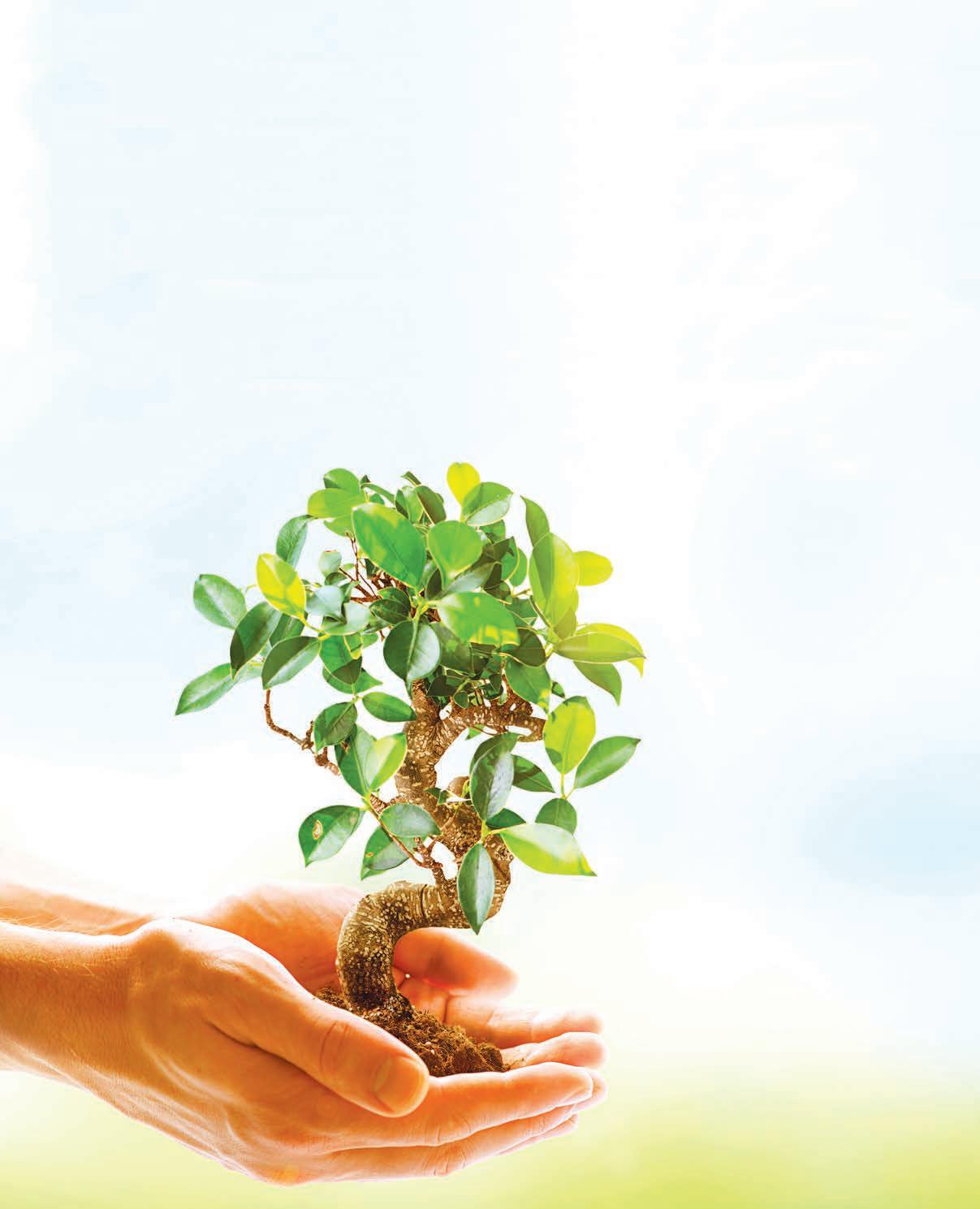 by Marlaina Donato
by Marlaina Donato
In her book One Makes the Difference: Inspiring Actions That Change Our World, environmental activist Julia Butterfly Hill asserts, “Everything we do and say does change the world. Even our inactions have impact.” Spring-boarding from Hill’s keen observation, the efforts each of us make can add up to much more than we ever imagine.
This year, the International Day of Forests and World Water Day are celebrated during the spring equinox (March 21 and 22), when nature kicks into high gear for annual renewal. For those dedicated to Earth awareness, this is a wonderful opportunity to commune with like-minded activists and learn about our impacts on vanishing resources.
Progress as Incentive
It is easy to be hopelessly discouraged when we look at the statistics of vanishing rain forests, polluted waterways and an astonishing output of “forever chemicals”, but focusing instead on the headway we’ve made worldwide can be a shot in the arm. The ozone layer, according to reliable accounts, is in recovery, thanks to reduced production of chlorofluorocarbons. Plastic policies in cities across the U.S., Europe and Australia are reducing waste, especially plastic shopping bags, plates, straws and cutlery. To fight the demise of vital coral reefs due to ocean acidification caused by the plastic pandemic, scientists are seeding reefs with coral offspring to promote restoration. The United Nations biodiversity conference held last year initiated an agreement among world leaders to restore 30 percent of natural resources by 2030 through concentrated efforts across the globe.
Fostering Forests
Major culprits of deforestation are food production (soy, corn and livestock), illegal logging and excessive paper manufacturing, which uses hazardous chemicals that compromise the air and human health. But there is much we can each do to counterbalance this devastation.
24 Metro Phoenix & Northern Arizona Edition NaturalAZ.com
green living
oatawaAdobeStock.com
Besides going paperless whenever we can at home and work, opting for paper alternatives like bamboo, hemp and sugarcane can reduce energy production and pollution. “The three Rs—recycle, reuse and reduce—are still very important,” says Todd Larsen, executive co-director at Green America. “Look for paper products made with post-consumer recycled fiber, and consumers can encourage companies they support to use recycled paper as much as possible.”

The people behind TreeSisters.org, a registered charity in the UK spearheading social change and tropical reforestation, explain, “Tropical forests are more than ‘the lungs’ of our world. They are the beating heart of the hydrological cycle. As weather stabilizers, rain creators and cleansers, they are intimately tied to our health and our food.”
Supporting reputable organizations for land and water extends beyond funds. Volunteer work, initiating a fundraiser and spreading the word about their efforts on social media or over a coffee break are love in action. Choosing to buy from organic farmers with Earth-positive practices like crop rotation, cover cropping and composting is an investment in the future. Brady Smith, the public affairs officer for the Coconino National Forest, in Arizona, emphasizes, “If people can practice ‘leaving no trace’ ethics, that would go a long, long way in helping preserve our forests.”
Walking Our Talk for Water

It is a frightening prospect that the world’s oceans will have more plastic than marine life in just 30 years. The impact of overfishing adds to the grim reality, but we can choose sustainable, wild-caught seafood that requires minimal fresh water (and produces fewer carbon dioxide emissions than the beef industry).

According to UNICEF and the World Health Organization, one in three people suffer from the consequences of contaminated water. Supporting clean water projects sponsored by charities like Water. org can help provide safe drinking water for families in impoverished countries. Donating $200 can help a family receive a water credit loan to connect to a water supply inside the home. A borrower’s payback rate in a country like the Philippines is an inspiring 99 percent.
Full Circle


Even surfing the net can have environmental implications. Instead of conducting web searches on Google, consider Ecosia. They use the profit they make from people’s searches to plant trees where they are needed most. What we do matters.
Canadian activist Maude Barlow’s inspiring words at the World Future Council last year remind us, “We can’t know what the outcome is going to be, but we have to have faith that others are doing very important work and that, collectively, that’s going to make a difference.”
Marlaina Donato is an author, painter and host of multimedia art exhibits intended for healing the community. Connect at WildflowerLady.com.


25 March 2023 Holistic,Wellness&MetaphysicalEvent forNewVisionCenter 18010SpiritualLivingPhoenixNTatumBlvd March 18th EmbracingYourJourneyExpo.com EmbracingYourJourneyExpo.com $5 admission
WORK HARDER AND SMARTER
BENEFITS OF HIGH-INTENSITY INTERVAL TRAINING
by Kirby Baldwin
High-intensity interval training (HIIT) workouts may sound like a trendy buzzword reserved only for experienced athletes, but this versatile, short-form exercise is safe and effective for just about everybody, including beginners, as long as it is done properly. According to Bogdan Goia, fitness expert and founder of Far Hills Fitness, in New Jersey, “HIIT training can benefit almost any age demographic, from teenagers to clients in their 70s and 80s.”

“In a recent study, even menopausal women diagnosed with osteoporosis successfully completed 13 months of high-impact HIIT with a very high adherence rate, with no injuries and high satisfaction ratings,” shares Debra Atkinson, a medical exercise specialist, certified
strength and conditioning coach, and founder of Flipping 50 (FlippingFifty.com)
Basic Principles of HIIT
A HIIT workout consists of a series of short bursts of intense activity interspersed with periods of rest or low-intensity movement called “active recovery”. A session is deemed to be high intensity when it is at or near
26 Metro Phoenix & Northern Arizona Edition NaturalAZ.com fit body bunyaritAdobeStock.com
peak effort, which translates to an eight or nine out of 10 on the exercise intensity scale, or 80 to 95 percent of an individual’s maximum heart rate. Such exertion is characterized by heavy sweating and an inability to say more than a few words without gasping for breath.
While HIIT workouts provide many of the same benefits as traditional, “steady state” exercise training, where the required amount of effort remains relatively consistent, HIIT sessions are typically shorter in duration, ranging anywhere from 10 to 30 minutes. HIIT is the perfect solution for busy people that are short on time or those hesitant to commit to longer exercise routines.
The exercise format is easily adaptable to most types of physical activities, such as running, weightlifting, swimming or biking, as long as a high level of intensity can be maintained. Adding to the convenience factor, HIIT does not require a gym membership or access to specialized equipment.
Benefits of a HIIT Workout Regimen

HIIT workouts have been the subject of numerous studies and have been shown to help with fat loss, improved metabolism and muscle gain. One study found that participants burned 25 to 30 percent more calories during a HIIT workout than in other forms of exercise. Because HIIT boosts metabolism, calorie burn has also been shown to last beyond the workout. Researchers have discovered other health benefits, from reducing blood sugar levels, resting heart rate and blood pressure, to balancing hormones, slowing the rate of cellular aging and even increasing longevity.
The practice also reduces the wear and tear that chronic cardio can inflict on the body. While federal guidelines currently recommend 150 to 300 minutes per week of moderate exercise, only 75 minutes per
week are recommended when the exercise is vigorous.
How to Get Started
For those looking to improve aerobic fitness, intervals typically involve a one-toone or one-to-two work-to-rest ratio. For example, in a one-to-one cardio workout, the person would exercise strenuously for 30 seconds and rest for 30 seconds.
If the goal is to gain strength, longer rest intervals are needed, with at least a oneto-five work-to-rest ratio. A person might exercise for 30 seconds, followed by 150 seconds of rest, for example, allowing their targeted muscles to recover and heart rate to drop before the next exertion.
HIIT should not be performed daily or when energy levels are low, to avoid injury and give the body enough time between workouts to rest and repair. Atkinson cautions, “Injury rates increase considerably doing more than 50 minutes per week of HIIT, due to the additional stress and need for recovery between. The good news is, there’s no need to do more. Short sessions actually get the best results.”
According to Goia, “I believe the key is to have a fitness professional select the exercise, monitor form and function, adjust work-to-rest ratios and monitor heart rate variability. HIIT workouts give my clients a 60-minute workout in 30 minutes and, if done correctly, will greatly increase the vitality, longevity and strength of any client.”
Jump Right In
For a flexible, efficient path to fitness, HIIT checks all the boxes. By starting small and slowly working up to a high level of intensity, a whole host of fitness gains and health benefits are possible without sacrificing time.
Kirby Baldwin is an editor and writer for KnoWEwell, the Regenerative Whole Health Hub and parent company of Natural Awakenings Publishing Corp.



We

27 March 2023
START A MEANINGFUL RELATIONSHIP this SPRI NG
invite you to join and experience a truly conscious, loving, dating environment with amazing members. Visit us at NaturalAwakeningsSingles.com START A MEANINGFUL RELATIONSHIP
Thriving With Multiple Sclerosis
H OW TO REDUCE INFLAMMATION AND PROMOTE NEUROREGENERATION
by Noelle Citarella, RDN, CDN, IFNCP
For people with multiple sclerosis (MS), the concept of “thriving” is becoming increasingly attainable thanks to advances in lifestyle-related research. While MS is not yet curable, life choices that reduce inflammation and promote neuroregeneration can slow or reverse disease progression. This is great news for nearly 1 million Americans living with MS, as estimated by a 2019 National Multiple Sclerosis Association study.

Tony Ferro, the founder of Change MS, credits diet modifications for improving his own symptoms of numbness, tingling, blurred vision, extreme fatigue, brain fog and depression. “It was hard work, but the more I learned and understood, the more I applied and the better I felt,” he says. Recognizing the transformative power of behavioral and attitudinal choices, his nonprofit helps people with MS adopt a wellness mindset and learn strategies to achieve their fullest potential.
According to a 2018 review article published in Current Nutrition Reports, a number of recent studies provide strong preliminary evidence that diet can influence the rise and progression of MS and its symptoms. Large-scale clinical trials are needed to be certain, but the emerging research suggests that the right foods not only provide essential nutrients for cellular function and repair, but also offer anti-inflammatory effects that slow MS activity, protect the nervous system from further damage and allow for nervous-system repair.
A study spearheaded by Terry Wahls, M.D., at the University of Iowa, found a significant improvement in fatigue, quality of
life and mental health in MS patients following a modified paleo diet that was rich in certain vitamins, minerals, amino acids and enzymes that have been found to support energy production and nerve repair.
Eating to Reduce Inflammation
Vegetables should make up the bulk of each meal, followed by a smaller portion of fruits. Eat many different-colored varietals to benefit from a full gamut of bioactive compounds. Consume sulfur-rich foods like broccoli, cabbage, asparagus and leafy greens daily.
Quality protein is essential, including omega-3-rich fish, like salmon, twice weekly. Saturated fats found in butter, cheese and red meat are associated with inflammation and should be limited. Use olive oil, which contains more than 30 neuroprotective antioxidants and has been shown to reduce inflammation and promote immune tolerance.
An elimination diet may identify food triggers that exacerbate MS symptoms.
Maintaining a Healthy Microbiome
Most people need 25 to 30 grams of fiber daily. Consume fermented foods, such as pickled vegetables and kefir, as well as prebiotic ingredients like onions, garlic, oats, bananas, apples, cocoa and flax seeds. The microbial fermentation of prebiotic fiber and
28 Metro Phoenix & Northern Arizona Edition NaturalAZ.com
healing ways
Prazis Images/Stock.Adobe.com
phytonutrients produces beneficial byproducts including vitamin K, biotin, neurotransmitters like dopamine and serotonin, and shortchain fatty acids, which help promote gut integrity, mood, immune balance and overall health.

Fasting Regularly
Studies have found that fasting for 12 to 16 hours increases cell repair and positively impacts hormone balance, metabolism and weight. Start with an overnight fast of 12 hours and slowly extend the fasting period one hour at a time to lengthen the body repair window.
Improving Sleep
The body does most of its restorative work while we sleep. Adequate, quality slumber is crucial for healthy immune function, balanced hormones and tissue repair. Ensure that the bedroom is quiet, dark and cool. To keep circadian cycles on track, get a daily dose of sunlight. Consider taking melatonin, L-theanine, lemon balm, holy basil, reishi mushrooms or other natural supplements recommended by a healthcare provider, as needed.
Remaining Active
For people with MS, regular physical activity can improve their quality of life. According to Dr. Lacey Bromley, a physical therapist who specializes in neurological rehabilitation, “Study after study examining the influence of exercise and physical rehabilitation on persons with MS continue to provide positive outcomes. With the correct rehabilitation program, there is ample opportunity for the central nervous system to recover lost function by enhancing previous motor programs or developing new neural pathways.”
Staying Hydrated
Fluids are essential for important bodily functions, including digestion, nutrient absorption, temperature regulation and toxin excretion. They also help prevent constipation.
Bladder dysfunction, a common MS symptom, leads many patients to restrict fluid intake. This is inadvisable because even mild dehydration can promote fatigue, cause urinary tract infections and impair cognitive function and exercise performance. A better approach is to decrease caffeine and alcohol consumption while slowly increasing fluid intake to build up a tolerance for additional fluids.
A Life Worth Living
By focusing more attention on the delights that can be added rather than what is taken away, people with MS can move forward on a much brighter path.
“We want to support our cells, brain and body with the nutrients we need to thrive, not just survive,” Ferro says. “Make small, obtainable goals, stay consistent and keep a journal to track your food, symptoms and journey along the way.”
Noelle Citarella is a registered dietitian specializing in neurological nutrition and autoimmune disease in the Buffalo, N.Y., area.
29 March 2023
SWEET LULLABY
BETTER SLEEP FOR CHILDREN
by Marlaina Donato and Kirby Baldwin
Sleep is essential for both survival and the ability to thrive, yet as children’s schedules get busier and they spend more time in front of screens, their average sleep time often decreases. While the American Academy of Pediatrics recommends that kids between the ages of 6 and 12 get nine to 12 hours of sleep per night for optimal health, they’re regularly getting less, and about 15 to 25 percent of youngsters and adolescents have trouble falling and staying asleep.
In a recent study published in The Lancet, researchers at the University of Maryland School of Medicine found that children that get less than nine hours of sleep per night have notable differences in areas of the brain that influence memory, intelligence and well-being compared to those that sleep more than nine hours. According to researchers, such insufficiencies in early adolescence can lead to long-lasting neurocognitive consequences.

Why Kids Aren’t Sleeping
Anna Esparham, M.D., FAAP, an integrative medical expert with the American Academy of Pediatrics, recommends that parents look for clues as to why their children can’t sleep, including stress, increased screen time and less physical activity. However, there may be other underlying issues.
A lesser-known culprit that may contribute to a child’s compromised sleep is impaired mouth syndrome (IMS), a term coined by dentist Felix Liao, a certified airway-centered
mouth doctor and past-president of the International Academy of Biological Dentistry and Medicine. “Most people, including many dentists, don’t realize the influence that the mouth has on the body,” he says. “The mouth is the portal to the inside. With impaired mouth syndrome, the child can still chew, smile and talk, but the body’s health can be compromised.”
While birth trauma, concussion and viruses can precipitate mouth breathing, and chronic allergies often exacerbate matters, immature swallowing can set off a cascade of problems. The mouth is a critical infrastructure for proper breathing, circulation, digestion, energy and sleep. IMS occurs when jaw development is insufficient, thereby giving rise to numerous difficulties, such as a narrower airway, which can cause hypoxia, or low levels of oxygen. Liao notes that poor sleep quality can also lead to learning and behavioral problems.
“Breastfeeding stimulates bone growth and jaw development through the tongue’s instinctive action and ideally enables a child to have a mature swallow by age 2,” says Amy Dayries-Ling, DMD, FAIHM, a national spokesperson for the American Dental Association. In her book Solve Your Sleep: Get to the Core of Your Snore for Better Health, Dayries-Ling connects the dots between the vital role of the tongue during breastfeeding, balanced stimulation from the vagus nerve and beneficial spaces between milk teeth for a well-developed dental arch.
Correcting Structural Problems
From a holistic perspective, improperly working muscles of the tongue, throat and face or a compromised jawbone can foster a predisposition to a number of seemingly unrelated conditions, including dental problems, teeth grinding, asthma, bedwetting, attention-deficit hyperactivity disorder, poor growth, swollen tonsils and pediatric obstructive sleep apnea. Dayries-Ling recommends that parents seek out a myofunctional therapist that can help retrain muscles and free up the airway. Building an integrative team is vital, including a dentist trained to address structural issues.
30 Metro Phoenix & Northern Arizona Edition NaturalAZ.com fizkes/AdobeStock.com healthy kids
As a certified, airway-centered mouth doctor, New Jersey-based holistic dentist Nemie Sirilan understands the link between sleep deprivation and airway obstructions. She uses 3D scans and thorough examinations to identify craniofacial abnormalities and customize treatments that correct structural anomalies.
“When I examine young patients, I want to see how baby teeth are forming, whether they have a tongue-tie and how their upper and lower jaws are positioned, to see if they have some kind of bad bite. These are all telltale signs of airway obstruction,” Sirilan explains, adding that another common indicator of breathing difficulties is the wearing down of tooth enamel that results from persistent teeth grinding.
Sirilan recommends that parents consult an airway-centered mouth doctor as soon as possible before other complications arise, noting that these problems are often easily corrected with customized corrective appliances, as well as collaborative consultations with other practitioners, including functional doctors, nutritionists, chiropractors and physical therapists to treat the whole person.

Life seems to be a much brighter place after a good night’s sleep, and kids are our future. Digging deeper for their optimum, long-term well-being is a vital investment.
Marlaina Donato is an author, painter and host of multimedia art exhibits intended for
healing the community. Connect at WildflowerLady.com.
Kirby Baldwin is an editor and writer for KnoWEwell, the Regenerative Whole Health Hub and parent company of Natural Awakenings Publishing Corp.
“I understand that great health depends on the ability to breathe efficiently, and the importance of this starts at birth,” says David Porter, a dentist and certified airway mouth doctor at Synergy Dental Center, who practices in Gillette, Wyoming, and Sturgis, South Dakota. He educates parents on the importance of proper facial and airway development in a popular lecture titled Faces Without Braces.
“Proper airway and facial development starts with education about nutrition, feeding techniques, lip ties, tongue ties, jaw position and oral posture,” he explains. “Spaces in between baby teeth are normal and desirable for proper development. Baby teeth should not be touching each other or have signs of wear. When we see this, we recognize that we already have a problem. Crooked teeth or a forward head posture in adolescents and adults is also a red flag for breathing and sleeping problems.”
To correct problems, Porter offers parents a number of options ranging from nonretractive orthodontics and orthopedics to orthotropics. “There is not a one size fits all when it comes to children's airway health,” he remarks. “Airway problems have reached epidemic proportions in our society, and we see this in the literature as chronic disease continues to become more prevalent. Breathing and sleeping are the most important factors in our effort to achieve optimal health.”
Empower Natural Health By Mouth
“The Mouth Is To Humans What Roots Are To Plants”
Your Pain, Fatigue & Chronic Illness May Be Rooted in:
1. Crowded Teeth & Deficient Jaws
2. Pinched Airway
3. Clicking/Popping Jaw Joints
4. Teeth Grinding
5. Tongue-Tie & Abnormal Swallowing
6. Weak Chin, Double Chin
7. Sunken Mid-Face, Flat Cheekbones
8. Teeth Pulled & Spaces Closed For Braces.
Impaired Mouth Symptoms Short List:
1. Aches & Pains in Head, Jaws, Neck Shoulders & Back
2. Fatique, Brain Fog, Lack of Motivation
3. Post-Nasal Drip & Frequent Colds & Flue
4. Teeth Grinding & Jaw Joint Troubles
5. Snoring, Sleep Apnea, CPAP Intolerance
6. Anxiety, Depression, Irritability/Hostility
7. “Empty Tank” From Adrenal Fatique, PMS/ED
8. Food Cravings; Caffeine, Sugar, Chocolate, Energy Drinks
“Get your airway back, get your sleep back, get your life back” – Angela, patient “Impaired Mouth Diagnosis should have been the first course in dental school.”
– Dr. J. Yelle, Monument, CO
An AMD’s Mission: To help you turn back illness and turn on wellness naturally through our evidence-based impaired Mouth diagnosis and Holistic Mouth solutions HolisticMouthSolutions.com

Join free Webinar to learn more. s

31 March 2023
@6_foot_tiger
Dr. Felix Liao, DDS
Give Your Child a Lifetime of Health
by Kristen Fischer, DDS
With an increase in the number of children experiencing health problems related to breathing and sleep issues, it begs the question, why is this happening and what can we do about it? In most cases, the underlying cause is related to the insufficient development of our jaws. While this may not sound significant, it is fundamental to our health and well-being.

This problem has been years in the making. Just look at how many children lack the room for third molars (wisdom teeth) and, despite having them extracted, need even more teeth pulled and orthodontic treatment (braces).
It’s not that our teeth have gotten bigger … our jaws have gotten smaller! While pulling a few teeth and braces
may seem like an adequate solution, it only masks an even greater problem. The lack of jaw real estate that results in crooked teeth also impairs a child’s ability to breathe and sleep properly. We now know that this can lead to a multitude of issues, from ADHD (attention-deficit/hyperactivity disorder) to behavioral problems to allergies.
We used to tell patients, “Your child will grow out of it.” We now know this not to be true. In most cases, the problems actually get worse and, with time, can lead to a slew of chronic health conditions.
Fortunately, there is a way to treat the underlying cause of this problem. Using a program like HealthyStart, it is possible to retrain the muscles of the lips and tongue to function properly. When they do, they have the ability to not only create
the much-needed space for teeth to erupt, but also for the airway to develop. Don’t think it is possible for your own muscles to move teeth and bone? Well, what happens when you don’t wear your retainer after the orthodontist straightens your teeth? That’s right, the muscles of your lips and cheeks move the teeth back to their original, crowded position.
32 Metro Phoenix & Northern Arizona Edition NaturalAZ.com
yarruta/123rf.com
Lack of room for wisdom teeth and crooked teeth are just a symptom of underdeveloped facial structures.
ack of room for wisdom teeth and crooked teeth are just a symptom of underdeveloped facial structures. By fixing the root cause of the problem, we not only give our children a more beautiful smile, but also a lifetime of better health.





Dr. Kristen Fischer is a 2013 graduate of the University of Maryland School of Dentistry. In addition to having memberships in the IAOMT (International Academy of Oral Medicine and Toxicology) and IABDM (International Academy of Biological Dentistry and Medicine), she has attained certifications from the American College of Integrative Medicine and Dentistry and the Institute for Functional Medicine. Fischer is a member of the Natural Dental Partners team, a healthcentered dental practice in North Phoenix. For more information or to make an appointment, call 602-775-5120 or visit MyNaturalDentist.com. See ad, pages 5 and 11. Advertorial

33 March 2023
june men ' s health april sustainable living T HREE-MONTH EDITORIAL CALENDAR & MARKETING PLANNER may women ' s wellness PhoenixAds@NaturalAZ.com
rawpixel/123rf.com
by Karen Shaw Becker, DVM

34 Metro Phoenix & Northern Arizona Edition NaturalAZ.com pawelprus/AdobeStock.com Natural Remedies for Pets SEVEN NON-TOXIC TREATMENTS FOR COMMON AILMENTS
natural pet
atural remedies and healing therapies are not just for humans, they also help pets overcome illness and maintain optimal health. Used properly, plants, herbs, essential oils and other natural, non-toxic substances can complement and often replace drugs and other chemical agents. Here are seven healthful solutions.
Coconut oil is a source of medium-chain triglycerides, which benefit cognitive function. It is also rich in lauric acid, a powerful antimicrobial agent for yeast infections, allergies and skin conditions (when used topically). Feed dogs and cats onequarter teaspoon of 100 percent organic, coldpressed, human-grade coconut oil for every 10 pounds of the pet’s body weight twice daily.

Manuka honey is an all-natural, effective remedy. Clinical trials have shown that it can eradicate hundreds of strains of bacteria, including certain an- tibiotic-resistant varieties. A Unique Manuka Factor rating of 10 or higher is recommended for medicinal use. Manuka honey can be used to manage resistant ear and skin infections, as well as large, superficial wounds that cannot be closed surgically. Given orally, manuka honey is effective at addressing H. pylori, the bacteria that contributes to gastrointestinal irritation, small intestinal bacterial overgrowth and excessive E. coli blooms in animals with dysbiosis.

Aloe vera has multiple applications. To reduce a dog’s discomfort from skin irritations, cuts or wounds, clean the affected area and apply the raw, inner gel of the plant to provide a soothing effect. For constipation, a small amount of whole leaf aloe vera juice, a natural laxative, can be added to a dog’s food. Inner leaf aloe juice, which doesn’t contain the skin, helps heal gastric ulcers, colitis and leaky gut.

Lavender oil is used in aromatherapy to help calm nervous or anxious animals. For a dog with noise phobia, place a few drops on their collar or bedding before a stressor occurs, if possible, or diffuse the oil around the house for a calming effect. Lavender oil can also be beneficial for treating hot spots. Add a few drops to manuka honey or coconut oil and apply after disinfecting the wound twice daily.

Oregano oil contains potent antibacterial and anti-parasitic properties. It can be used to calm itchy skin, soothe irritated gums and assist in balancing a dog’s gut flora. It is also a beneficial herb for dogs with kennel
cough or recurrent infections. Oregano oil should always be diluted before using it in or on pets.

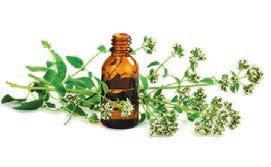
Ginger is a widely used, non-toxic, non-irritating remedy for soothing tummy troubles. It can be given orally or used in oil form by adding a few drops to a carrier oil, such as coconut or olive oil, and massaging the mixture into the skin on the pet’s belly. Alternatively, add small amounts of freshly grated ginger or the dry herb to a tasty meatball or other yummy treat. Use no more than one-sixteenth teaspoon for kitties, one-eighth teaspoon for small dogs under 10 pounds, one-quarter teaspoon for mediumsized dogs, one-half teaspoon for large dogs and three-quarter to one teaspoon for giant breeds. Give the ginger one to three times a day, as needed.

Chamomile is an effective calming agent that has analgesic and anti-spasmodic properties and is beneficial in soothing the central nervous system. Use a cool chamomile tea bag against a wound, irritation or bug bite on the dog’s or cat’s skin to provide a soothing effect. Something else to consider is a soothing chamomile after-bath rinse. Add five chamomile tea bags to two quarts of very hot water and steep until the water is cool for up to three hours to allow the maximum amount of polyphenols to release into the water. Remove the tea bags and pour the rinse over a freshly bathed pet from the neck down. Massage into the skin and do not rinse.
Veterinarian Dr. Karen Shaw Becker has spent her career empowering animal guardians to make knowledgeab-le decisions to extend the life and well-being of their pets. To learn more, visit DrKarenBecker.com.

35 March 2023 Guzel Studio/AdobeStock.com mates/AdobeStock.com solstizia/AdobeStock.com chandlervid85/AdobeStock.com srekap/AdobeStock.com Gummy Bear/AdobeStock.com areeya_ann/AdobeStock.com N
business directory
Connecting you to the leaders in natural health care and green living in our community. To find out how you can be included in the Business Directory, email PhoenixAds@NaturalAZ.com or visit NaturalAZ.com and download our media kit.
ALTERNATIVE MEDICINE
ALLERGY CLEARING TECHNIQUE
480-676-0510
Info@AllergyClearingTechnique.com AllergyClearingTechnique.com
Learn a process to potentially clear food allergy response. Home study course with training manual and training videos. Not NAET. No shots, No drops, No bloodwork—No kidding. See ad, page 11.
ARIZONA LEECH THERAPY
Pavel Gershkovich, CHP, CRP, PMP, Therapist


8765 E Bell Rd, Ste 110, Scottsdale 480-621-6041 • ArizonaLeechTherapy.com ArizonaLeechTherapy@gmail.com

Pavel Gershkovich, owner of Arizona Leech Therapy, is a professional medicinal leech therapist. He is here to help you find a natural, drug-free solution for your medical conditions, such as cardiovascular, high blood pressure, migraine, urology/ prostate, varicose veins, and deep venous thrombosis. See ad, page 29.
LEADING EDGE WELLNESS
MacKenzie Kalt, Owner/Director


4050 E Greenway Rd, Ste 5, Phoenix 480-594-5052 • NatPainTreat.com
Providing some of the most advanced natural technologies for those struggling with chronic pain, injuries, stress, migraine headaches, PTSD, insomnia, Lyme disease, autoimmune disorders, skin conditions, and much more. Visit our website to learn more. See ad, inside front cover.
META SELF HEALTH
Michael Chrisemer
MetaSelfHealth.com

Hello! Please visit my website for comprehensive views on rapid healing and breakaway longevity through nuanced nutrition, endogenous stem cell activation and accelerated detoxification via the MUSE Dry Fasting protocol. This protocol also promises very high potential to remove toxins associated with the mRNA experimental shots. Every good wish, cheers.


NATURAL MEDICINE & DETOX
2701 N 7th St, Phoenix 602-307-0888
NaturalMedicineDetox.com
We offer professional medical assistance with one of our Doctors of Acupuncture & Oriental Medicine, MD(H), or Classical Homeopaths. We also have several self-elect options for our many detox services. Please call to schedule a free 15-minute consult to learn what service might be the best option. See ad, page 25.
PIHMA COLLEGE & CLINIC

Acupuncture, Herbal Medicine and Homeopathic Clinic
301 E Bethany Home Rd, Ste A-100, Phoenix 602-274-1885 • pihma.edu
PIHMA offers Acupuncture Treatments, Herbal Consultations, Acute and Constitutional Homeopathic Consultations, as well as Auricular Acupuncture, Cupping, Moxibustion, Gua Sha and Tui Na. Our medicines have been used for thousands of years to treat numerous conditions, including pain, stress and more. PIHMA is a teaching clinic and offers affordable pricing.
SW HERB SHOP & GATHERING PLACE
148 N Center St, Mesa 480-694-9931 • SWHerb.com Store.SWHerb.com
Kathy Gould and Madalyn Johnson, herbalists and proprietors, offer medicinal bulk herbs and specialty tea blends, herbal extracts, certification classes, community and therapist rental space, medicine-making supplies, and more. See ad, page 11.

ART CLASSES
WATERCOLOR ART CLASSES
Allura Westly
3611 E Sunnyside Dr, Phoenix AlluraWatercolor@cox.net 602-469-0524 • AlluraWaterColor.com
Allura Westly, master teacher, opens her sanctuary studio to all levels, beginner to advanced. Learn fluid color technique, drawing and composition. Small class of eight students. No talent required, just a desire to create.
CLEANING SERVICES
BENNETT’S CARPET & UPHOLSTERY CLEANING

Valleywide Service • 480-994-4988
BennettsCarpetCleaningAZ.com
Eco-friendly carpet and upholstery cleaning. Featuring organic cleaners and odor removal products derived from renewable seed and vegetable sources. No perfumes, solvents or other hazardous products. No phosphates. Products also available for in-home use. Licensed and owner operated since 1974. See ad, page 21.
DENTISTS
MILLENNIUM DENTAL ASSOCIATES
5705 N Scottsdale Rd, Ste D-110, Scottsdale 480-948-0560
MillDental.com

Millennium Dental offers more than 50 years’ experience in holistic dentistry, including advanced general dentistry


Certified by the IABDM. See ad, page 9.
MY DENTIST
Dr. Michael Margolis and Dr. Stephen Kovar
2045 S Vineyard Rd, Ste 153, Mesa 480-833-2232 • MyDentistAZ.com

A holistic and biological approach to your dental needs and overall health. Bio-compatible dentistry, esthetic dentistry lumineers/veneers, family dentistry and much more. See ad, page 3.
NATURAL DENTAL PARTNERS
3134 W Carefree Hwy, Ste 9, Phoenix 602-775-5120 • MyNaturalDentist.com
The doctors at Natural Dental Partners take the time to listen to your concerns and use their extensive experience to help you achieve better health. Using the latest technology (such as lowdose 3D imaging, CEREC, lasers, PRF, ozone and treatment of sleep disorders), they believe in a team approach to help you achieve your healthcare goals. Check out MyNaturalDentist. com or ABreathOfHealth.com to see how they can help you. See ad, pages 5 and 11.
36 Metro Phoenix & Northern Arizona Edition NaturalAZ.com
DOCTORS
BUTTERFLY HOLISTIC CENTER
Melanie Icard, NMD
1430 E Missouri Ave, Ste B127, Phoenix 602-353-7712 • ButterflyHolistic.com
Dr. Icard specializes in biological medicine, peptides, PRP, aesthetics and ozone therapy. Her offerings include holistic antiaging medicine, pain reversal, natural and traditional aesthetics, ozone therapy, holistic ketamine therapy, and sexual health regeneration. See ad, pages 21 and 33.
ENERGY HEALING
KIM CARTER, MA, HTCP
15215 S 48th St, Ste 154, Phoenix Kim@IntuitiveKim.com IntuitiveKim.com
Kim is an Intuitive and Healing Touch Certified Practitioner offering guidance when you feel out of alignment with your authentic self. Stress, fear, anxiety and grief/loss throw us off balance, making it challenging to access inner wisdom. Sessions include reading and clearing your energy field; and simple, practical self-healing tools to keep you balanced and grounded. See ad, page 22.
FENG SHUI
FENG SHUI 81
Lori Thomas
Feng Shui Instructor/Practitioner

480-370-3310 • FengShui81.com
Feng shui is a study of how energy flows in one’s home. Lori Thomas offers private consultation and classes to teach how to correct energy imbalances to prevent mishaps in one’s life, improving health, abundance, relationships and more. She is an Intuitive with extensive training in feng shui and healing arts. See ad, page 19.
PEST CONTROL
ARIZONA ORGANIC PEST & TERMITE CONTROL

Organic Pest Control
602-923-1457 • ArizonaOrganic.com
PET CARE
ANDREA BRIGGS, AKA “CRITTER DOC”
ASAM, Sh. Reiki, HTAP Communicator, Healer, Counselor 602-317-1543 • CritterDoc1@cox.net
SpiritAnimalWisdom.com
With a gentle healing touch, Andrea provides wellness counseling, energy healing, animal communication, and intuitive counsel for pets and their people.




SCHOOLS
SOUTHWEST INSTITUTE OF HEALING ARTS

1538 E Southern Ave, Tempe 480-994-9244
Info@swiha.edu • swiha.edu
Nationally accredited college offers holistic health and wellness degrees, diplomas, certificates of excellence, continuing education and personal development, oncampus and online. Financial aid available. See ad, outside back cover.
SPIRITUAL CENTERS
DIMENSIONS OF HEAVEN AND EARTH

11108 N Frank Lloyd Wright Blvd, Ste E16, Scottsdale 732-832-1036
DimensionsOfHeavenAndEarth.com
Dimensions of Heaven and Earth is Scottsdale’s exciting, new one-stop Spiritual Experience: a center of healing and insight combined with a store full of unique gifts from local artisans. With training and tools for your personal development, we are excited to help you take your spiritual journey to new levels! See ad, page 13.
ECKANKAR

The Path of Spiritual Freedom
1-877-300-4949 • EckankarArizona.org Eckankar.org • HearHU.org
Facebook.com/EckankarArizona
THE SUMMIT LIGHTHOUSE OF PHOENIX
4105 N 20th St, Ste 115, Phoenix 480-442-5020
SummitLighthousePhoenix@gmail.com

SummitLighthousePhoenix.org
Dedicated to sharing Saint Germain’s Violet Flame. All faiths welcome. Learn how you can become a modern day mystic. We are dedicated to sharing the Teachings of the Ascended Masters® to help you bring in joy and peace to the world. Learn what the requirements are to make your ascension. See ad, page 19.
mark your calendar
Sol y Luna Tantric Shamanic Festival
April 6-9 • Starts 8am each day
A four-day retreat experience with a festival vibe to heal, transform and learn how to create meaningful relationships and intimacy.
Cost: $575 | 10% off with SOLYLUNA10

25100 SW 153rd Ave, Homestead, FL More information/register at: SolyLunaFestival.com or text 941-402-7560/email Support@SolyLunaFestival.com
mark your calendar
5-Day Feng Shui Training

April 25-29 • 9am-5pm
Learn Classical Feng Shui with the Raymond Lo School of Feng Shui & Destiny. This is an in-person intensive five full-day program.
Cost: $3,400 new student tuition/ $1,000 return students or $280 for 5th day
6207 N Cattletrack Rd, #7 Scottsdale
More information/register at: FengShuiByJen.com
Avoid being exposed to dangerous chemicals when all-natural and safer alternatives work just as well and last longer. See ad, page 25.
Eckankar is an active, individual, creative spiritual practice. A companion and roadmap for your journey home—to the heights of SelfDiscovery and God-Discovery, and beyond. Come along and discover the most secret part of yourself. The key to spiritual freedom lies within you. Explore life as a Soul Adventure. See ad, page 22.
37 March 2023
Local Farmers Markets
Roadrunner Park Farmers Market 3502 E Cactus Rd, Phoenix
Saturdays Oct-May 8am-1pm | Jun-Sep 7am-11am
Facebook.com/RoadrunnerParkFarmersMarket
Singh Meadows Farmers Market 1490 E Weber Dr
Fridays, Saturdays & Sundays 8am-2pm
Facebook.com/SinghFarms
Sun City Farmers Market 16820 N 99th Ave
Thursdays Oct-May 9am-1pm
Facebook.com/Sun-City-Farmers-Market631299790224049



The Capitol Farmers Market 1700 Adams St, Phoenix
Thursdays 10:30am-1:30pm
ArizonaCommunityFarmersMarkets.com
Uptown Farmers Market 5757 N Central Ave, Phoenix
Wednesdays Oct-Apr 9am-1pm & May-Jun
NOTE: Please check market websites and ArizonaCommunityFarmersMarkets.com for more information on days and hours, and any restrictions.



Ahwatukee Farmers Market
4700 E Warner Rd, Phoenix
Sundays Oct-May 9am-1pm
Jun-Sep 8am-11am
Facebook.com/AhwatukeeFarmersMarket
Care 1st Farmers Market
328 W Western Ave, Avondale
Tuesdays Jul-Oct 8am-noon
ArizonaCommunityFarmersMarkets.com
Carefree Farmers Market
1 Sundial Circle
Fridays Oct-May 9am-1pm
Jun-Sep 8am-11am
Facebook.com/CarefreeFarmersMarket
Downtown Chandler Farmers Market
3 S Arizona Ave
Saturdays Oct-May 9am-1pm
Jun-Sep 7am-10:30am
Facebook.com/ChandlerFarmersMarket
Downtown Mesa Farmers Market
1 E Main St
Saturdays 8am-noon
dtMesaFarmersMarket.com
Downtown Phoenix Farmers Market 721 N Central Ave
Saturdays Oct-Apr 8am-1pm
May-Sep 7am-11am
DowntownPhoenixFarmersMarket.org
Gilbert Farmers Market
222 N Ash St
Saturdays Oct-Mar/Apr 8am-noon Apr/May-Sep 7am-11am GilbertMarket.com
High Street Farmers Market 5415 E High St, Phoenix
Sundays Oct-May 10am-1pm
Facebook.com/Farmers-Market-on-HighStreet-2244771575799425
Mommas Organic Market
Arrowhead Farmers Market
7780 W Arrowhead Towne Center, Glendale
Saturdays Oct-May 9am-1pm | Jun-Sep 8-11am Facebook.com/Getlocalazfarmersmarkets GetLocalArizonaEvents.com
Mommas Organic Market
Glendale Farmers Market at Cabela’s 9380 W Glendale Ave, Glendale, AZ 85305
Sundays Sep-May 10am-2pm | closed for summer
Facebook.com/Getlocalazfarmersmarkets
GetLocalArizonaEvents.com
Old Town Scottsdale Farmers Market
3806 N Brown Ave
Saturdays 8am-1pm
ArizonaCommunityFarmersMarkets.com
Power Road Farmers Market 4011 S Power Rd, Mesa
Monday-Saturday 9am-5pm | Sunday 9am-4pm PowerrdFarmersMarket.com
8am-noon
Saturdays Nov-Apr 9am-1pm & May-Oct 8am-noon
UptownMarketAZ.com
Verrado Community Farmers Market N Market Pl & W Main St, Buckeye
Sundays Oct-Jun 9am-1pm
Facebook.com/VerradoCommunityFarmersMarket
NORTHERN ARIZONA
Flagstaff Community Farmers Market 211 W Aspen Ave, City Hall Parking Lot
Sundays May-Oct 8am-noon
FlagstaffMarket.com
Prescott Farmers Market
Dignity Health, YRMC
900 Iron Springs Rd, Miller Valley Lot
Saturdays 7:30am-noon
PrescottFarmersMarket.org
Sedona Summer Community Farmers Market
Tlaquepaque/Creekside, 336 Hwy 179
Fridays May-Oct 8-11:30am
Sedona-Farmers-Market.com
Sedona Winter Community Farmers Market
Wells Fargo Bank Parking Lot 2201 W State Rte 89A, West Sedona
Sundays Oct-May noon-4pm
Sedona-Farmers-Market.com

38 Metro Phoenix & Northern Arizona Edition NaturalAZ.com
123rf.com/lola1960


Color your way to relaxation! ksym/123rf.com GROW YOUR BUSINESS Contact us for special ad rates. PhoenixAds@NaturalAZ.com
780 Hours - 71 Calendar Weeks
This online diploma offers foundational courses in holistic modalities, transpersonal psychology, and business development. You will learn about traditional and integrative approaches to healing, and you will get to choose the elective courses that excite you! You will be prepared to serve as a spiritual coach, intuitive guide, holistic consultant, and so much more! We are committed to your unique vision, offering lifetime entrepreneurial support and career services.
Choose from one of three specialty options to tailor your education to your vision:
Option 1: Advanced Professional Hypnotherapy
Option 2: Spiritual Coach & Healing Botanicals & Earth Ceremonies

Option 3: Spiritual Coach & End-of-Life Doula
Start Dates: -c:=m

Integrative Healing Ar ts Practitioner Diploma Online Program Learn Holistic Modalities and Coaching Techniques Online
-- � SOUTHWEST INSTITUTE of HEALING ARTS graduaung great people www.swiha.edu 5/1/23 7/17/23 Contact an Admissions Coach Today 480-994-9244 We have a feeling you are going to love it! Financial Aid is available to those who qualify. 1538 E. Southern Avenue Tempe, AZ. 85282 I info@swiha.edu I www.SWIHA.EDU














































 by Kiki Powers, MS, CNC
by Kiki Powers, MS, CNC







 by Marlaina Donato
by Marlaina Donato



 by Marlaina Donato
by Marlaina Donato










 by Marlaina Donato
by Marlaina Donato








































































